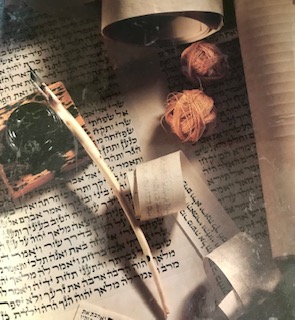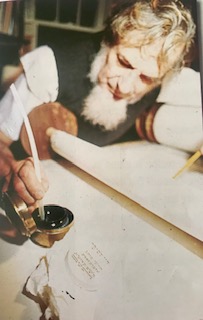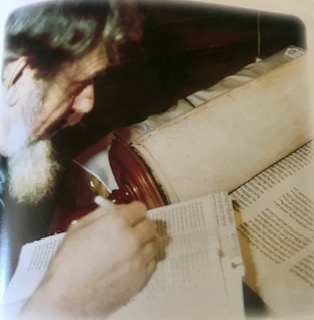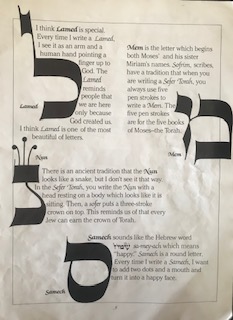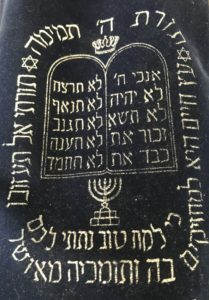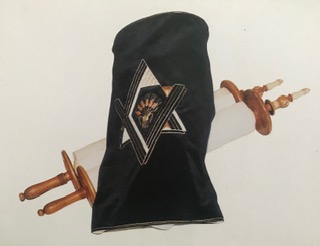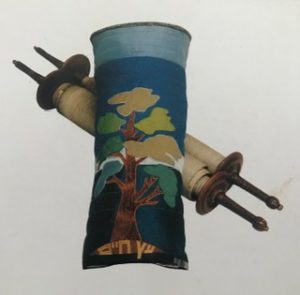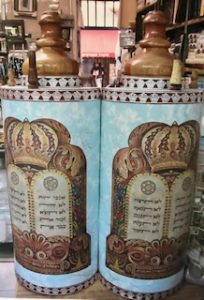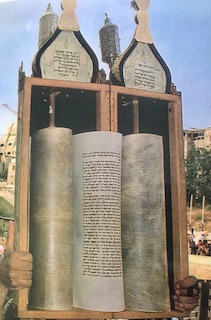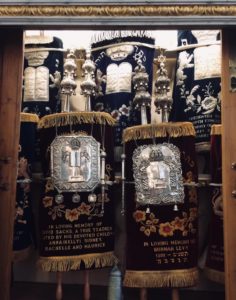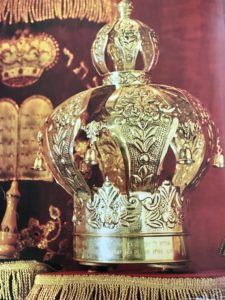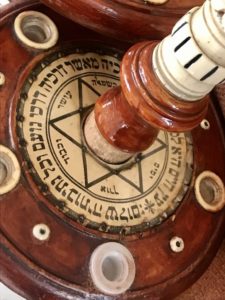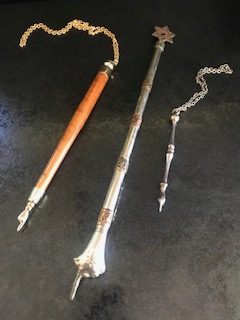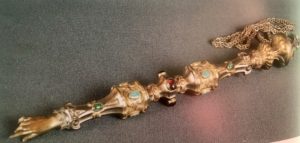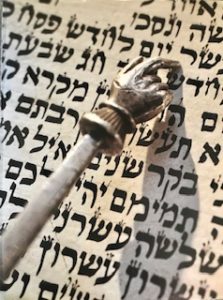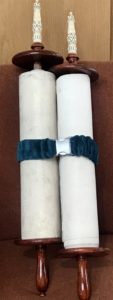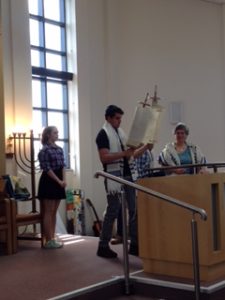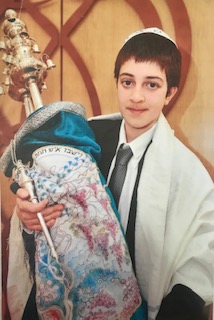This article is going to explain the importance of the Jewish Torah.
It will explain why this is such a special Holy Book in so many ways.
What is the Torah?
A book of Mega Importance- essentially the keystone of Judaism!
Why?
The Torah is the Holy Book of the Jewish people. It consists of the first five Books of the Old Testament, also known as the five Books of Moses or the Pentateuch.
The Torah is the first part of the Tenach. (The second part is Nevi’im -the books of the Prophets and the third part is Ketuvim -The Writings).
Torah is the Hebrew word meaning teaching/law.
The ‘teaching’ – Jews spend their lives studying and learning from it.
The ‘law’ – the Torah is the Jewish rule book. It contains 613 rules governing our whole way of life- rules for living together in peace and kindness as well as laws which protect the weak, the poor and the young. The most important of these rules are the Ten Commandments. The degree of adherence to the rules is determined by the branch of Judaism followed. (see Subdivisions within Judaism.)
The Torah also contains very important sayings such as ‘Love your neighbour as yourself’. This summarises the ethos of the whole book.
Being the first part of the Old Testament, the Torah is essentially our early history. It contains stories of the Patriarchs- Abraham, Isaac and Jacob as well as our Matriarchs- Sarah, Rachel, Rebecca and Leah. We also find famous legendary characters such as Noah, Joseph, Moses and David.
What Does The Torah Look Like?
We call the Torah a book but it’s actually a giant scroll over 30 metres long!
How is The Torah Made?
It is handmade by a Sofer – a scribe. He will be a very religious Jew but also a talented calligrapher. It can take him up to 3 years of careful work to make just one!
Jews have been making the Torah for over 3000 years! Of course there were no shops to supply materials that we take for granted today. Only natural materials were available, such as animal skin, wood, feathers etc.
Precious metals such as gold and silver, were used. Other base metals, such as steel, could be made into weapons so were forbidden.
Amazingly, we still make the Torah the same way today!
The Scroll
It is written on Kosher parchment or vellum. This is usually cow or goat skin. The animals are never killed for their skin. They must have died of natural causes or been killed for food. The skin must also be free from disease. It is soaked, cleaned, dried and stretched into sheets. Approximately 250 of these will be sewn together to make the scroll. Over 60 skins may be required for one Torah. Even the thread comes from the animal- the sinews of its thigh are cleaned and twisted together. This sounds pretty gross to us nowadays! Remember there were no craft shops to buy the necessary materials. Also, this is the ultimate in recycling and makes the Torah even more special!
The scroll is attached to two large wooden rollers known as Trees of Life.
The Torah itself is seen as a “Tree of Life,” (based on passage in the Book of Proverbs)
It is a growing and abundant source of spiritual sustenance to Jews.
The Writing
The Sofer will use a quill, usually a turkey feather. He will copy the words from a Tikkun, a book containing the Torah text.
The Torah is written in Classical Hebrew from right to left in a beautiful, decorated style.
Classical Hebrew is made up of consonants and vowels. Once you have mastered these it is relatively easy. However the Hebrew in the Torah is written solely in consonants with no punctuation, known as ‘unpointed text’. It is very difficult to read without practice.
To keep his writing straight the Sofer scratches lines on the parchment using a sharp twig or a thorn attached to a thin wooden stick.
Special ink is made from natural materials including carbon and gum arabic from plant sap. This makes it very black and sticky so that the writing is distinctive and won’t fade.
There will be at least three or four columns of writing on each sheet of parchment.
I particularly love the fact that the last letter in the Torah is a ‘Lamed’ (L) and the first letter a ’Beit’ (B) which when joined make the Hebrew word for heart!
How much do we love our special book!!!
Rules About The Writing
These are many rules eg: letters must not be smudged or even touch each other.
If the Sofer makes a mistake, he can usually erase it with a piece of glass and make a correction. (Glass is used instead of a metallic blade because it’s made from sand – a natural substance).
The exception to this is any mistake in the word ‘God’. It cannot be corrected. Instead the whole piece of parchment, maybe days or weeks of work, is ruined.
It is buried in a Holy place and work starts on a replacement. This is because God’s name must always be totally perfect. Even if the correction was invisible to the naked eye, the mistake would still be present underneath.
Before writing God’s name, the Sofer must have a Mikveh, or ‘Holy’ bath.This makes him not just physically clean but also spiritually clean. It makes him ready to direct his heart and mind to his work.

In practice because God’s name appears so frequently in the Torah, the Sofer will leave a space for the Holy word. He will then go to the Mikveh a couple of times a week. Then he fills in God’s name, being extra careful not to make any mistakes!
He even uses a specially trimmed feather and a separate pot of ink for this most important of tasks!
Each parchment sheet is checked 3 times for mistakes before being sewn on to the previous sheet. The only concession to modernity is that now it can be digitally scanned instead of by humans!
N.B. The most important rule about the finished work is that one must NOT touch the writing. This could smudge the ink thus rendering it not Kosher (fit for purpose). Above all, the Torah is Holy and to be treated with respect at all times. (See Yad, below).
The Torah in Synagogue
Most Synagogues have at least 2 or 3 Torah scrolls and some of the larger Synagogues may even have a dozen or more! These may have been bequeathed by congregation members or have come from other Synagogues. There are amazing stories of wartime heroism where Christian communities, recognising their importance, have rescued scrolls and hidden them in their own crypts!
Where is it Kept?
The Holy Ark or Aron Hakodesh is the focal point in every Synagogue. When a new Synagogue is built, the Ark must face Jerusalem, our Holiest city, which means the congregation faces east when praying.
It is essentially a large cupboard containing the Torah scrolls.
In front of the Holy Ark is the Parochet, Curtain/s, which will often be embellished with Jewish symbols. These are usually blue. (see Symbols of Judaism).
(The Parochet will be exchanged for a white one during the High Holy Days).
Hanging above or sometimes in front of the Holy Ark will be the Ner Tamid, Everlasting Light. This reminds us of God’s eternal presence.
The Torah Decorations
The scroll will be covered with a Mantle. This can be made from a sumptuous fabric such as velvet, silk or satin. The covers will be decorated with Jewish symbols such as The Star of David, the Ten Commandments, the Menorah and the Crown.
The mantle below has a depiction of the Tree of Life.
Sometimes Torahs may be constructed inside a more sturdy, protective and beautifully decorated wooden case.

With most scrolls, Rimonim, (literally pomegranates) the Torah finials, decorate the upper scroll handles. These are typically made of gold or silver and adorned with little bells. The bells are a reminder of those that adorned the Priests’ robes in Biblical times and they serve to catch the attention as the scroll is carried around the Synagogue after being read.
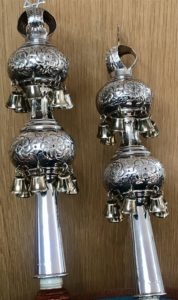
Sometimes the bells will be attached to a Crown. This represents the majesty and law of the Torah and is also a symbol of God as ‘King of the Universe’- the words that praise God in many of our prayers.
There is often a gold or silver Breastplate or shield over the mantle to protect it. Again, this will be engraved with Jewish Symbols. On the breastplate below there are also lions- these are literally ‘guarding’ the Holy Book and also represent God’s ‘mighty’ power!
This beautiful Torah from my Synagogue in Birmingham has ivory posts and decorated tops! (Of course ivory is an illegal material today).
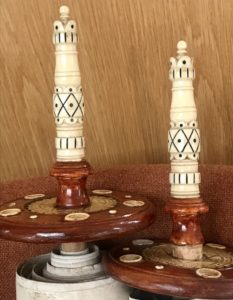
A Torah scroll will always be accompanied by the Yad which hangs down the front. Yad is the Hebrew word for hand so this is literally the ‘pointer’ to follow the words.
Remember, you are not allowed to touch the Holy writing with your hands!
The Yad is made of silver, gold or wood and may be plain or bejewelled. I’ve even seen an ivory Yad in the British Museum with a jewelled bracelet and a ring on its pointed finger!
Under the mantle, the scroll is held together with a velvet belt or a silk or satin tie.
When is it Read?
The Torah is read in a cycle. It takes a year to complete the readings and then we start again at the beginning, the same day. This means we never come to the end!
To celebrate this event we have a festival called Simchat Torah, literally ‘Rejoicing of the law’. We carry our scrolls and model versions around the synagogue at least 7 times. We dance and sing. We wave flags.
The best part is when sweets are thrown, (ostensibly for the children!) to spread the joy!
Specific Torah portions are also read on certain festivals. An example of this is the story of Jonah on Yom Kippur. This story highlights the idea of repenting one’s sins and being forgiven by God. (See Jewish Festival Stories).
How is it Read?
A Parasha (Portion) is set to every Shabbat, which will be named after it.
In Orthodox Synagogues the Torah is read on Shabbat (Saturday), Mondays and Thursdays. In Reform and Progressive Synagogues it is read weekly on Shabbat. (see Subdivisions within Judaism).
Two members of the congregation will be chosen to open the Ark. Whenever the Ark is opened or the Torah scrolls carried around, the congregation must stand. A member will then lift the Torah out of the Ark. Another will ‘undress’ the scroll, prior to it being unrolled to the portion of the day. This is known as Gelilah (Literally ‘To roll up’). (The Torah would never be opened out to its full extent of over 30 metres! This would be extremely disrespectful and could damage or soil it.)
Performing an honour like this is known as a Mitzvah. Another example is being called up to say the Blessings before and after the Torah reading, known as the ‘Aliyah’ or ‘calling up’. This person/s will be called up using their Hebrew name.
The Rabbi reads and translates from the Torah from right to left using the Yad. At other times it can be read by the Bat/Bat Mitzvah or a chosen member of the community.
In Orthodox communities only men are allowed to read from the Torah and it is customary to chant it in a special set of notes.
Members of the congregation may follow the reading using a Chumash. This literally means 5, as in the 5 Books of Moses. It is the Torah in book form which contains ‘pointed’ Hebrew ie: consonants AND vowels and the English translation. It also gives detailed explanations of the text and its historical context.
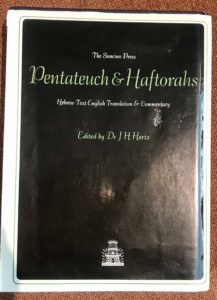
After being read the Torah is raised high and turned around 360 degrees. This is called Hagbah (Literally ‘To Lift’). This is to show the congregation the Torah writing and to demonstrate that God is ‘all around’ us.

It is then ‘dressed’ before being carried in procession around the Synagogue.
As this happens, the congregation turn to face it everywhere it goes. Some members bow their heads in respect as it passes them. Others touch the mantle with their Tallit or Siddur and then kiss these. These are physical expressions of how much Jews love the Torah and by extension, God Himself.
Summary
In this article we have looked at the importance of the Jewish Holy Torah.
There are many reasons for this.
It is our history book and story book: The record of the journey of the Jewish people towards a better world.
It is our rule book: The record of the laws and values by which we live.
The Torah’s importance is demonstrated by the way it is handmade by the Sofer.
He uses his artistic skills to keep the chain of Torah alive.
The Torah has pride of place in the Synagogue inside the Holy Ark. The holiness of the Torah is enhanced by the beautiful way it is decorated. It is handled and read with the greatest love and respect.
Jews regard the Torah as the most wonderful gift from God.
If one imagines the Jewish people as the body then the Torah is its heart!

